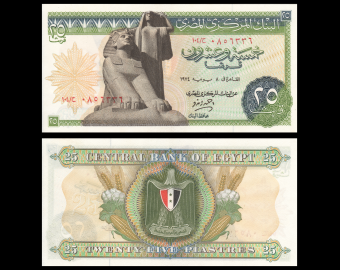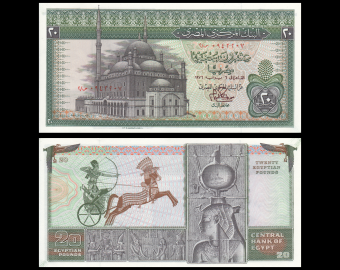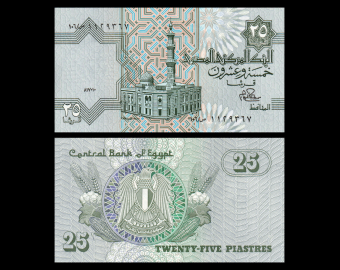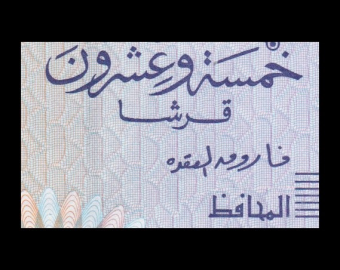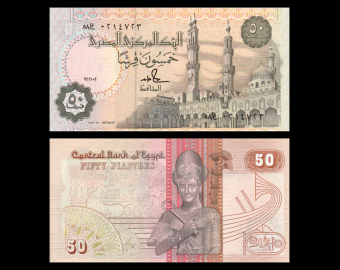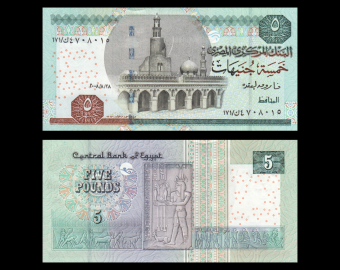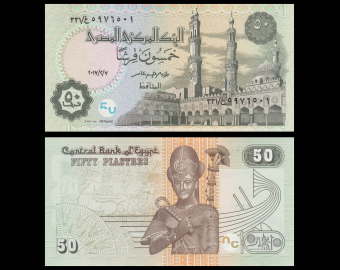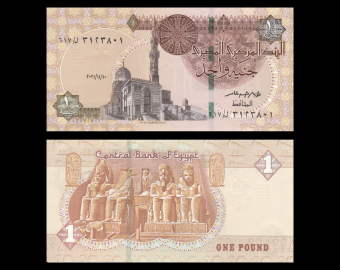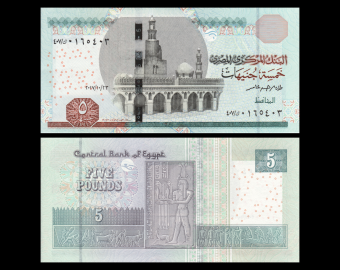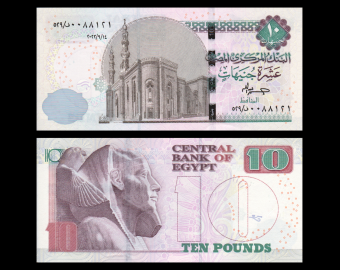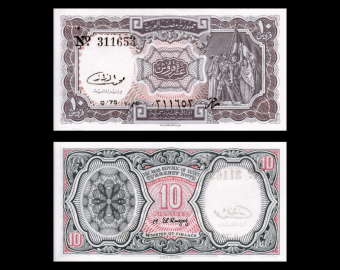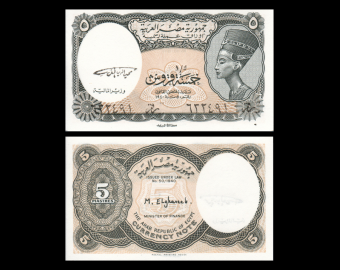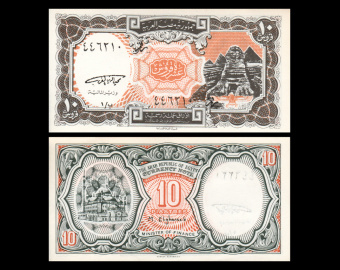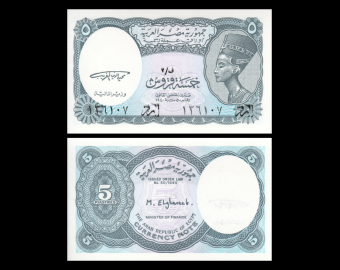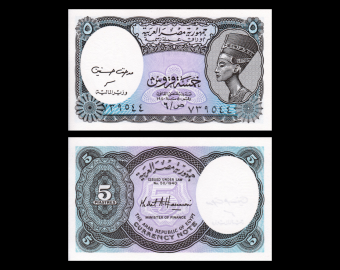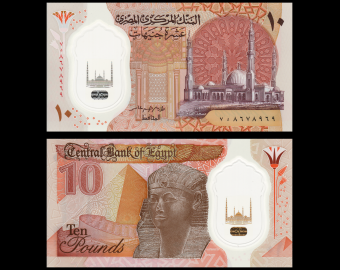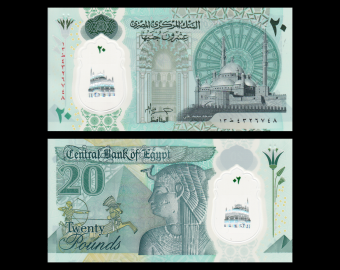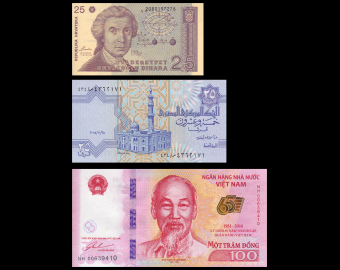No products
Catalog
Egypt There are 18 products.
Banknote & Workd Paper Money Collection - Egypt. Currency: piastre, pound
In 1834, a khedival decree was issued, adopting an Egyptian currency based on a bimetallic standard (gold and silver) on the basis of the Maria Theresa thaler, a popular trade coin in the region. The Egyptian pound, known as the geneih, was introduced, replacing the Egypti...
Banknote & Workd Paper Money Collection - Egypt. Currency: piastre, pound
In 1834, a khedival decree was issued, adopting an Egyptian currency based on a bimetallic standard (gold and silver) on the basis of the Maria Theresa thaler, a popular trade coin in the region. The Egyptian pound, known as the geneih, was introduced, replacing the Egyptian piastre (ersh) as the chief unit of currency. The piastre continued to circulate as 1⁄100 of a pound, with the piastre subdivided into 40 para.
In 1885, the para ceased to be issued, and the piastre was divided into tenths (عشر القرش 'oshr el-ersh). These tenths were renamed milliemes (malleem) in 1916. The legal exchange rates were fixed by force of law for important foreign currencies which became acceptable in the settlement of internal transactions. Eventually this led to Egypt using a de facto gold standard between 1885 and 1914, with E£1 = 7.4375 grams pure gold.
At the outbreak of World War I, the Egyptian pound was pegged to the British pound sterling at EG£0.975 per GB£1. Egypt remained part of the Sterling Area until 1962, when Egypt devalued slightly and switched to a peg to the United States dollar, at a rate of EG£1 = US$2.3. This peg was changed to 1 pound = 2.55555 dollars in 1973 when the dollar was devalued. The pound was itself devalued in 1978 to a peg of 1 pound = 1.42857 dollars (1 dollar = 0.7 pound).
The pound floated in 1989. However, until 2001, the float was tightly managed by the Central Bank of Egypt and foreign exchange controls were in effect. The Central Bank of Egypt voted to end the managed-float regime and allowed the pound to float freely on 3 November 2016; the bank also announced an end to foreign exchange controls that day. The official rate fell twofold. The Egyptian pound was also used in Anglo-Egyptian Sudan between 1899 and 1956, and Cyrenaica when it was under British occupation and later an independent emirate between 1942 and 1951. The National Bank of Egypt issued banknotes for the first time on 3 April 1899. The Central Bank of Egypt and the National Bank of Egypt were unified into the Central Bank of Egypt in 1961.
Wikipedia
➠
Banknote & Workd Paper Money Collection - Egypt. Currency: piastre, pound
In 1834, a khedival decree was issued, adopting an Egyptian currency based on a bimetallic standard (gold and silver) on the basis of the Maria Theresa thaler, a popular trade coin in the region. The Egyptian pound, known as the geneih, was introduced, replacing the Egypti...
Banknote & Workd Paper Money Collection - Egypt. Currency: piastre, pound
In 1834, a khedival decree was issued, adopting an Egyptian currency based on a bimetallic standard (gold and silver) on the basis of the Maria Theresa thaler, a popular trade coin in the region. The Egyptian pound, known as the geneih, was introduced, replacing the Egyptian piastre (ersh) as the chief unit of currency. The piastre continued to circulate as 1⁄100 of a pound, with the piastre subdivided into 40 para.
In 1885, the para ceased to be issued, and the piastre was divided into tenths (عشر القرش 'oshr el-ersh). These tenths were renamed milliemes (malleem) in 1916. The legal exchange rates were fixed by force of law for important foreign currencies which became acceptable in the settlement of internal transactions. Eventually this led to Egypt using a de facto gold standard between 1885 and 1914, with E£1 = 7.4375 grams pure gold.
At the outbreak of World War I, the Egyptian pound was pegged to the British pound sterling at EG£0.975 per GB£1. Egypt remained part of the Sterling Area until 1962, when Egypt devalued slightly and switched to a peg to the United States dollar, at a rate of EG£1 = US$2.3. This peg was changed to 1 pound = 2.55555 dollars in 1973 when the dollar was devalued. The pound was itself devalued in 1978 to a peg of 1 pound = 1.42857 dollars (1 dollar = 0.7 pound).
The pound floated in 1989. However, until 2001, the float was tightly managed by the Central Bank of Egypt and foreign exchange controls were in effect. The Central Bank of Egypt voted to end the managed-float regime and allowed the pound to float freely on 3 November 2016; the bank also announced an end to foreign exchange controls that day. The official rate fell twofold. The Egyptian pound was also used in Anglo-Egyptian Sudan between 1899 and 1956, and Cyrenaica when it was under British occupation and later an independent emirate between 1942 and 1951. The National Bank of Egypt issued banknotes for the first time on 3 April 1899. The Central Bank of Egypt and the National Bank of Egypt were unified into the Central Bank of Egypt in 1961.
Wikipedia
-
Egypt, P-042b, 25 piastres, 1974
Egypt 25 piastres pick № : P-42b qual : Neuf / UNC date : 1974 Central Bank of Egypt
7,00 €Available -
Egypt 20 pounds pick № : P-48 qual : Neuf / UNC date : 1976 Central Bank of Egypt 190 x 95 mm
49,00 €Available -
Egypt, P-054a, 25 piastres, 1980
Egypt 25 piastres pick № : P-54a qual : Neuf / UNC date : 17.01.1980 Central Bank of Egypt
2,80 €Available -
Egypt, P-057h, 25 piastres, 2008
Egypt 25 piastres pick № : P-57h qual : Neuf / UNC date : 28-10-2008 Central Bank of Egypt
0,95 €Available -
Egypt, P-058b2, 50 piastres, 1992
Egypt 25 piastres pick № : P-58b2 qual : Neuf / UNC date : 22.11.1992 Central Bank of Egypt
2,55 €Available -
Egypt, P-063be2, 5 pounds, 2008
Egypt 5 pounds pick № : P-63be2 qual : Neuf / UNC date : 28.08.2008 Central Bank of Egypt
3,60 €Available -
Egypt, P-070b, 50 piastres, 2017
Egypt 50 piastres pick № : P-70b qual : Neuf / UNC date : 7.2.2017 Central Bank of Egypt
0,80 €Available -
Egypt 1 pound pick № : P-71d qual : Neuf / UNC date : 10.11.2017 Central Bank of Egypt
0,75 €Available -
Egypt 5 pounds pick № : P-72d qual : Neuf / UNC date : 2017.10.23 Central Bank of Egypt
1,60 €Available -
Egypt, P-073l, 10 pounds, 2022
Egypt 10 pounds pick № : P-73l qual : Neuf / UNC date : 14.09.2022 Central Bank of Egypt
2,57 € Before 2,85 € -10%Available -
Egypt, P-184b, 10 piastres, 1986-96
Egypt 10 piastres pick № : P-184b qual : Neuf / UNC date : L. 1940 (11/1986 - 1/1966) Arab Republic of Egypt
1,10 €Available -
Egypt, P-185, 5 piastres, 1997
Egypt 5 piastres pick № : P-185 qual : Neuf / UNC date : L. 1940 (1997) Arab Republic of Egypt
1,00 €Available -
Egypt, P-187, 10 piastres, 1997
Egypt 10 piastres pick № : P-187 qual : Neuf / UNC date : L. 1940 (1997) Arab Republic of Egypt
1,05 €Available -
Egypt, P-188, 5 piastres, 1998
Egypt 5 piastres pick № : P-188 qual : Neuf / UNC date : L. 1940 (1998) Arab Republic of Egypt
0,90 €Available -
Egypt, P-190Ab, 5 piastres, 2002
Egypt 5 piastres pick № : P-190Ab qual : Neuf / UNC date : L. 1940 (2002) Arab Republic of Egypt
0,90 €Available -
Egypt, P-w081a, 10 pounds, 2022, polymer
Egypt 10 pounds pick № : P-w81a, polymer qual : Neuf / UNC date : ND (2022) Central Bank of EgyptFirst egyptian polymer banknote
3,75 €Available -
Egypt, P-w082a, 20 pounds, 2023, polymer
Egypt 20 pounds pick № : P-w82a, polymer qual : Neuf / UNC date : ND (2023) Central Bank of Egypt
5,50 €Available -
Lot 3 banknotes : Croatia Egypt Vietnam
Lot of 3 banknotes Croatia, P-19a, 25 dinara, 1991 Egypt, P-57h, 25 piastres, 2008 Vietnam, P-125, 100 dông, 2016 qual : Neuf / UNC
5,89 € Before 6,69 € -12%Available


